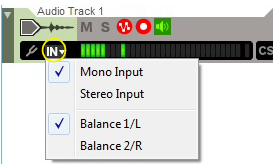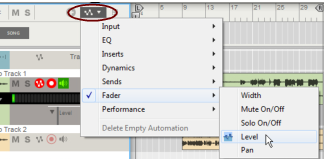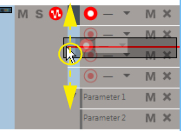In Tuner mode, you can tune a connected instrument - an electric guitar, for example. See “Using the Tuner” for more info.
To the right of the Tuner button is the Select Audio Input drop-down list. Here, you select which audio input(s) to use for the track. See “Selecting audio input(s) and defining mono or stereo” for more info.
The Input Meter shows the level(s) of the input signal(s). If the selected audio input is mono, the Input Meter displays a single LED bar. If the audio input is in stereo, the Input Meter displays two parallel LED bars. See “Setting input level(s)” for details about setting input levels.
|
•
|
To the right of the “Record Enable” button is the “Groove Select” drop-down list. Here you can select a ReGroove channel for all clips on the lane. See more about ReGroove in “The ReGroove Mixer”.
|
•
|
To the far right is the “Delete Automation Lane” (X) button. Clicking this button will delete the lane (and all clips on it). If there are clips on the lane, a dialog appears prompting you to confirm deletion. See “Deleting parameter automation lanes” for alternative ways of deleting parameter automation lanes.
|
•
|
To the far right is the “Delete Pattern Lane” (X) button. Clicking this button will delete the lane (and all clips on it). If there are clips on the lane, a dialog appears prompting you to confirm deletion. See “Deleting pattern lanes” for alternative ways of deleting pattern lanes.
|
•
|
A new note lane will be created and automatically record enabled. See “Recording notes using the “Dub” and “Alt” functions” for more details.
A new note lane will be created and automatically record enabled. At the same time, the previous note lane, or (if loop is activated and the Song Position Pointer is between the Left and Right Locators) the clips between the Left and Right Locators, will be muted. See “Recording notes using the “Dub” and “Alt” functions” for more details.
|
•
|
|
|


















